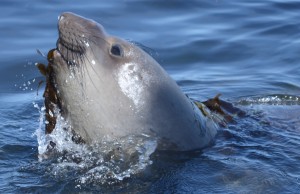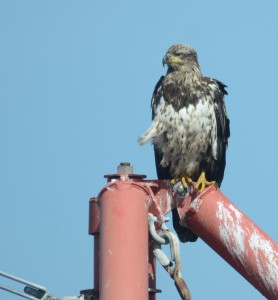By late afternoon, light winds (0 to 10 knots) had not done much but turn in direction from east-southeast to south and back to southeast. The wind finally turned to light westerlies at sunset. It was a sunny day with high cloud and haze. The barometer continued its halting and slow descent and the forecasters continue to call for more of the same.
There were no tour boats observed in the Ecological Reserve today and although a few sports fishing boats skirted the edges of the reserve, only one was noted speeding through, just after 7:15 this evening.
Ecologically, spring is progressing with daylight lengthening and excellent morning low tides, rich with the productive smell of freshly growing seaweed. The bull kelp beside the jetty has reached the surface at low tide and will soon form a band of kelp forest just a bit shallower than the sea urchins. I haven’t seen the Sea Otter in A few days but if it sticks around it could clear more habitat deeper by removing grazers like sea urchins and abalone, where kelp will grow.
The Northern Elephant Seals, Harbour Seals and the two species of sealions are busy jockeying for position on haul-outs, sleeping a lot during the day and in the case of the seals moulting. Elephant seals don’t do anything half way, they are the deepest divers of the seal clan and they have the most radical moult in which they lose skin along with the fur. The elephant seals moulting in the garden have just started the process with early spots on the top of rear flippers, under the forelimbs and under the chin. When they get in the water for their daily (at least the last few days) swim they do a lot of scratching and rubbing on the rocks which probably helps loosen things.

Northern Elephant Seal #5850 draping himself in Desmarestia ligulata, an abundant brown algae that produces, stores and secretes sulphuric acid. Could this be a moult enhancing seaweed wrap?
The Glaucous-winged Gulls are exhibiting more and more pre-nesting behaviours including pairs tipping their bills back together, practicing standing on the backs of mates, balancing with their wings, pairs doing the head down herky-jerky (looks like they are practicing regurgitation), pulling tufts of grass to mark territory, gathering nesting material and grappling with gull neighbours in fairly violent skirmishes involving pulling feathers and beak to beak struggling.
Black Oystercatcher pairs have staked their territories barely above the high tide line and fairly evenly spaced around the shores of Great Race and I am pretty sure there are at least one pair over on West Rocks. These birds alternate being secretive with being absolutely raucous.
There are quite a few bald eagles here every day. Here is a photo of a juvenile looking for dinner amongst the gulls and geese.

This juvenile Bald Eagle almost had the look of a Red-tailed Hawk. Thanks to Dick Cannings for identification confirmation.
There were no visitors today and maintenance was all routine.
